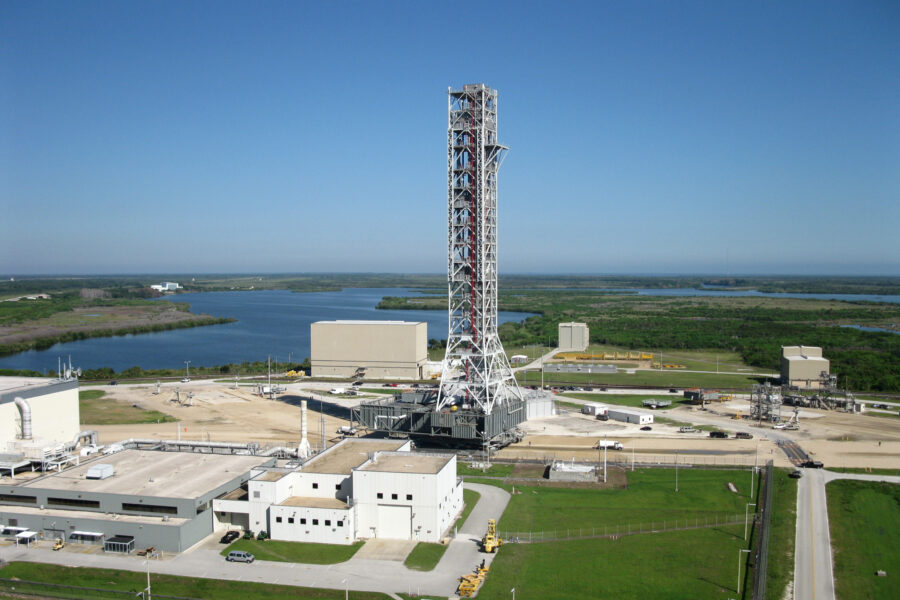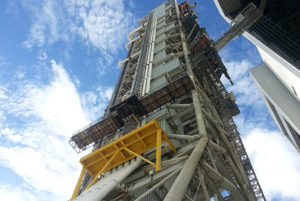Mobile Launchers Then and Now: Parallels Between 1969 and 2019

A lot has changed on Earth in the 50 years since mankind first walked on the moon. 18, 250 days have passed; the population has more than doubled to 7 billion and counting; the Internet evolved from a 3-month-old invention into a worldwide source of technological revolution. As our world has changed, so have the machines that propel us out of it.
Despite this transformation, clear parallels exist between the machines and missions of 1969 and immediately thereafter and those of 2019, as the nation once again aims for the moon – and beyond.
1969 – Mobile Launcher
Fifty years ago, Reynolds Smith and Hills, now known as RS&H, designed the mobile launcher from which astronauts Neil Armstrong, Buzz Aldrin and Michael Collins rocketed into space.
John Crump was one of the many associates who worked on the launcher’s design.
John designed the extensible columns used at the launch pad to support the mobile launcher, each of which weighed 40,000 pounds. Together, they had a load capacity of 3 million pounds. John also worked on the water systems that dampened exhaust vibrations caused by the rocket’s engines at launch.
A senior engineer at RS&H, John can’t remember exactly where he was during the moon landing, but he has not forgotten his emotions surrounding the event.
“What a fantastic engineering feat to be a part of!” he remembers thinking.
Following the design of the first mobile launchers, RS&H continued to build its relationship with the agency through a variety of projects. Now, five decades later, RS&H associates are once again playing a role in a mission to the moon by designing and leading construction of Mobile Launcher 1.
2019 – Mobile Launcher 1 (ML1)
RS&H began design of a new mobile launcher in 2006, when it was conceived for a different program. Paula Endicott, who now serves as construction project manager, has worked on the current launcher since the very beginning.
Currently, 20 to 35 RS&H associates across the country are working to ready ML1 for its first launch. At the project’s peak, up to 90 associates nationwide supported the design of the ML1 structure, ground systems, facility systems and ground support equipment.
The first SLS launch is slated for summer 2020 and will be unmanned. By the mid-2020s, however, NASA plans to take astronauts to the moon.
That’s where architect Alice Schultz, electrical engineer Daniel Vigeant and their respective project design teams come into play.
Modifications for Moon Landing
In its current configuration, ML1 will not accommodate manned rockets, making modifications to the launcher necessary to support the mission to the moon.
Alice and Daniel and their respective teams are now designing alterations, but construction can’t begin until after the unmanned launch in summer 2020.
“After the launch, they’ll leave the launcher on the pad for 30 days, so they can make sure everything is operational,” said Alice. “Then they’re going to take it off the pad and immediately start on construction for the second launch.”
Emergency Egress System (EES)
Alice’s team is designing the next generation emergency egress slide wire system, which will be similar to the type of systems used in the Apollo and Shuttle programs. Emergency egress systems afford astronauts a quick, safe exit in the event of an on-pad anomaly.
During the Saturn/Apollo era, the evacuation option for astronauts was a zipline that they connected to via harnesses and slid down. In the Shuttle era, the astronauts’ evacuation system changed, progressing through multiple iterations.
Initially, the crew used the slide wire to evacuate through a single large gondola. Eventually, however, astronauts had access to multiple pre-stationed baskets connected to slide wires, each of which could transport three astronauts to the remote landing area near a safe-house bunker.
The baskets will be back in some form for the manned trips to the moon, likely mimicking their Shuttle era counterparts.
Life Safety Mobile Launcher Tower and Base Modifications
Since ML1’s reconfigured SLS design wasn’t originally intended for manned launches, some of the areas on the tower that would have functioned as walkways are currently occupied by operational equipment for the unmanned launch.
In order to create a safe, functional environment for astronauts, several modifications will be necessary ahead of the manned launches. Daniel and his team are now designing those changes for the ML1.
As part of the effort, Daniel’s team is creating new egress pathways from the crew access arm to the EES. They are also working on the design changes necessary to accommodate the EES on the mobile launcher.
“There are several evacuation options for astronauts, depending on the situation,” said Daniel. “One of the routes, of course, includes the emergency egress system that Alice’s team is working on; my team’s job is to make sure getting to those evacuation routes is safe and easy for astronauts in cases where evacuation is necessary.”
The team is also outfitting the ML1 with monitoring devices. That includes installing closed-circuit television cameras along the pathway to track astronauts along their access routes and as they board the spacecraft capsule, which is standard NASA procedure. Infrared cameras will also be installed to monitor the pathways for heat or fires not visible to the naked eye. On a more mundane note, the team is also building a new restroom on level 274, where the crew access arm is located.
Mobile Launchers, Then and Now
Before they begin work on the life safety systems, Daniel’s team must first focus on structural reinforcements for the launcher. This includes modifications to the primary structural framing on the tower and structural accommodations for new walkways, platforms, and systems.
Mobile Launcher 1 actually needs additional supports on the launch pad similar to the Saturn/Apollo era extensible columns. When it was time to design new extensible columns, NASA revisited the designs created by John in the ’60s for inspiration.
For its part, the Saturn rocket needed extensible columns to prevent excessive deflection and mechanical movement of the launcher.
“The ignition of the rocket’s liquid-fueled engines and its ramp up to full thrust caused an initial uplift on the launcher until the rocket’s hold-down mechanisms were released,” said Paula. “This was a concern, particularly in a launch abort situation where the rocket rapidly settled back down.”
The need in 2019 didn’t result from lift, but from the weight of the fully fueled SLS rocket. The Saturn rocket was around 500,000 pounds without kerosene and the liquid hydrogen and liquid oxygen that were loaded into the rocket just before takeoff. With its combination of both solid rocket boosters and large liquid hydrogen and oxygen tanks, the Gross Lift Off Weight (GLOW) of the SLS rocket is considerably higher than those in the Apollo/Saturn era. The current mobile launcher was initially built for a lighter rocket, so the extensible columns provide an added foundation and support for the heavier SLS rocket.
One of Many
Though RS&H’s involvement in mobile launchers has been extensive, the Practice’s experience in this area stands as just one example of its NASA work. Other recent projects include the creation of the Johnson Space Center asteroid laboratory and work on the Vehicle Assembly Building.
Together, RS&H projects over the past five decades have represented many different service areas, with associates serving in a number of roles. But the same feeling of awe and pride has underlaid each one. As John thought during the moon landing, what an honor to be a part of it all.
Learn more about our Aerospace services.
